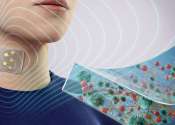The skin is the outer covering of the body. In humans, it is the largest organ of the integumentary system made up of multiple layers of mesodermal tissues, and guards the underlying muscles, bones, ligaments and internal organs. Skin of a different nature exists in amphibians, reptiles, birds. Human skin is not unlike that of most other mammals except that it is not protected by a pelt and appears hairless though in fact nearly all human skin is covered with hair follicles. The adjective cutaneous literally means "of the skin" (from Latin cutis, skin).
Because it interfaces with the environment, skin plays a key role in protecting (the body) against pathogens and excessive water loss. Its other functions are insulation, temperature regulation, sensation, synthesis of vitamin D, and the protection of vitamin B folates. Severely damaged skin will try to heal by forming scar tissue. This is often discolored and depigmented.
In humans, skin pigmentation varies among populations, and skin type can range from dry to oily. Such skin variety provides a rich and diverse habit for bacteria which number roughly a 1000 species from 19 phyla.









